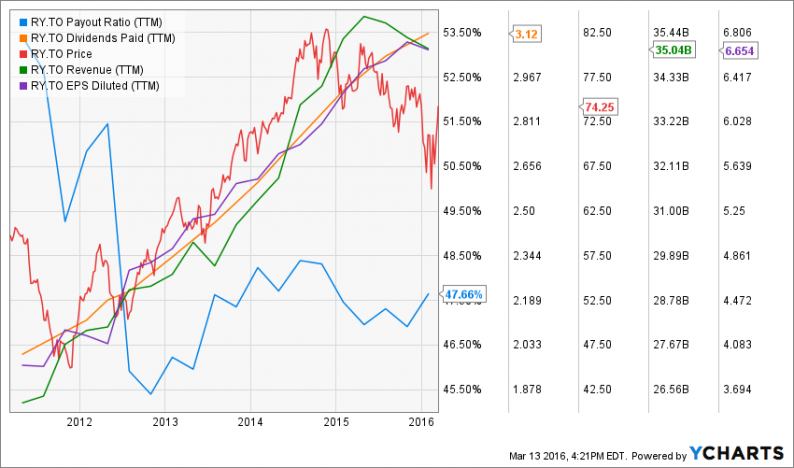The stock market is definitely not a place for the faint of heart. At one point in time this February, the S&P 500 dropped by more than 10% (-10.51% on February 11th, 2016). On the Canadian market, the TSX dropped by more than 15% since its highest point in 2015. Now that we have been hearing more discussion about oil production stabilization from major oil countries, it seems both markets are on their way to recovering a good part of their drops. This is also a great opportunity to chase down bargains and make a few purchases. While the best timing might already be behind us, there are still good opportunities in this crazy market.
Recently, I reviewed 6 companies that raised their dividend within the first 2 months of the year. A reader of mine highlighted that only one company was Canadian (CNR.TO or CNI on the US market). This is why I decided to discuss a few great buy opportunities on the Canadian market in this article.
Royal Bank (RY.TO) (RY)

source: Ycharts
At the moment, Royal Bank is my favorite Canadian Banks. I even bought 29 shares to complete my children’s tuition fund in February. The reason why I bought RY.TO (RY for the US ticker) instead of buying another Canadian bank is linked to how RBC generates its revenues.
The company is a leader in capital markets and wealth management. Two sub-sectors poised for strong growth in the upcoming years. As Canada’s population is aging, fortunes are passing from the older generation and this new generation will face many challenges. This is why wealth management will become a priority for many families. The capital market sub-sector is more volatile than classic savings and loans activities. However, it is also a great source of growth for many banks. RBC has developed quite an expertise in this field.
At the same time, I tend to favor a bank that is less linked to classic savings and loans at the moment. Economic growth perspectives are inexistent for Canada in the upcoming two years mainly because of the oil industry. This will be a long period when consumers won’t borrow more than what they show on their balance sheet at the moment.
In order to be very sure of my purchase, I also use a double stage dividend discount model. After all, what really matters for me is the value of a company considering how much it will pay me back in dividends in the future. I didn’t go crazy with the dividend increase rate with a 6% growth rate for the first 10 years and I dropped it to 5% afterward. Here’s what my calculations look like:













Leave A Comment